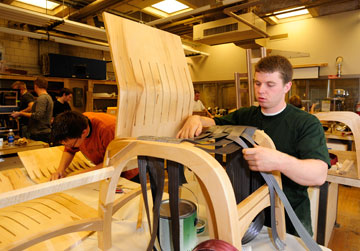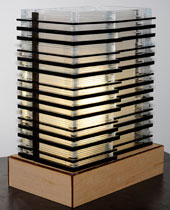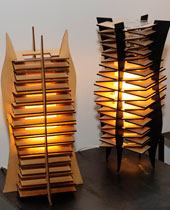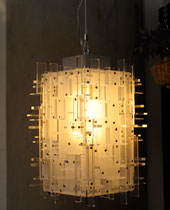AMES, Iowa -- When Iowa State University's solar decathlon house is displayed on the National Mall in Washington, D.C., in October, it will be decked out with furniture, lamps, birdfeeders and ceramics created by students in three College of Design classes.
During the past semester, the Iowa State team competing in the U.S. Department of Energy's 2009 Solar Decathlon collaborated with students in Mark Chidister's furniture studio, Ingrid Lilligren's advanced ceramics studio and the File-to-Fabrication class taught by Mikesch Muecke and Pete Goche.
The result is a collection of one-of-a-kind pieces designed specifically for the compact 800-square-foot solar house: Chairs that can be side tables, bird feeders made of metal, biobased plastic and twigs, and ceramic tiles with ground recycled glass embedded.
Along the way, art students worked with architecture students, architecture students worked as industrial designers, art students worked in teams, and all students learned about the give and take that comes with designing for a client.
Versatile and portable furniture

Brian Boeding, senior from Waterloo, works on a chair.
The 17 students in the furniture studio knew they had to create a dinner table and seating for eight (each solar decathlon team must prepare and serve dinner for eight during the competition). They also wanted the furniture to be configured for other uses and for portability within the small house.
"So we conceived of three projects--a table, a set of chairs and a bench unit," said Chidister, associate professor of art and design.
The table, made of three parts that lock together, can be configured in several ways. It can be a long rectangular table or a nearly square shape. It can be used for two, four, six or eight diners. It can be broken down to a demi-lune (half moon) table, a drop leaf table or a writing desk.
Equally versatile are the four chairs and bench unit. The chairs are designed so the backs can be removed, rotated and re-attached to form a side table. Or the back can be stowed under the seat, forming an ottoman. The bench unit has four modules, two have sides and two are cubes. These can be configured as one long bench, or as benches and end tables.
The furniture is made of maple or a combination of maple and red gum (the heart wood of the sweet gum tree). Both trees are native to Iowa. The chair seats are woven from recycled seat belts.
"We wanted the furniture to be physically light and also visually light," Chidister said.
Ceramics re-use and reduce

Stephanie Bittner, senior from Urbandale, creates a plate.
The ceramics studio worked on dinnerware and tiles for window surrounds. Four advanced students who were working on dinnerware collaborated on the design and creation of place settings for the house. Each created a place setting from red clay, which included a dinner plate, salad/dessert plate, bowl and cup.
"Red clay is a low-fire clay, so we aren't using a lot of energy. It's also the most abundant form of clay found on the earth," said Lilligren, professor of art and design.
In addition, the students made ceramic tiles for window surrounds. The tiles will have photocopier transfer images of plant materials from the site. Students added ground glass from the Ames Resource Recovery Plant to the clay that makes the tiles.
"We experimented with the ground glass as part of learning how various materials could contribute to the final project," she said. "This gave students the opportunity to think about where raw materials come from and how raw materials become finished materials."
"This project gave the students the opportunity to be part of something that's much larger," Lilligren said. "They could exert some degree of aesthetic control, but they had to work within the framework. If your options are limited, you tend to become much more creative."
Architects produce
In the File-to-Fabrication class taught by Muecke and Goche, nine upper-level architecture students learned a computer program (Rhino 3D) for designing objects on the computer in three dimensions. Then they used four manufacturing devices to produce the physical objects--laser cutter, 3D printer, vacuum former and CNC router.
The students produced hanging light fixtures, sconces, freestanding lamps and bird feeders. The solar decathlon team will select which pieces will best integrate into the house when the interior is completed.
Muecke, architecture associate professor, said the class is a unique experience for students because architects "normally hand off their building designs in the form of 2D plans, sections and elevations to builders or developers who make it into a building."
"In this case, we're doing the whole thing--designing and producing it," he said. "You have to deal with different issues."
"This is more industrial design or rapid prototyping. We're making prototypes of objects that you could make multiples of," Muecke said. "Architects usually design one of a kind. As such, it is a great learning opportunity for students to be involved in the whole process, from design of objects through their modifications to the final production and fabrication."



